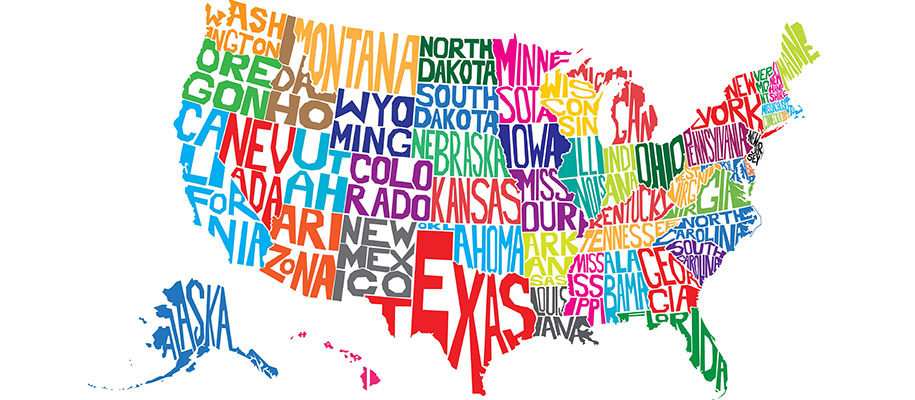If out-of-state college sticker prices make you hyperventilate—as some out-of-state public university costs can run more than $50,000 total—you may have options for tuition discounts. One way is to attend an institution that participates in a regional compact and charges lower tuition to students from the same region. Sometimes states or individual universities also have limited agreements with another state, county, or university system (particularly those located on state borders). Ask the admission offices at your colleges of interest whether they have a reciprocity agreement with students from your state or county. But before you do that, here’s what you should know about them.
Please note: Participating states and universities may change, so always check official websites for the latest updates on who participates in these regional compacts.
Regional compacts for tuition reciprocity
The US has four regional compacts—Western, Southern, Midwestern, and New England—and within each, participating institutions agree on a reduced tuition rate for regional students. For instance, when Ty Veldhuisen shopped for colleges, he explored two universities that participated in the Western Undergraduate Exchange regional consortium. The Washington State resident ended up accepting a spot at Humboldt State University in California, where he received an award that saved him approximately $6,500 per year. This put his tuition costs in the $10,000 range—about $2,000 more than his in-state universities would have been. The WUE exchange made going out of state achievable for him.
While this story is an ideal outcome of reciprocity agreements, each region functions a bit differently, and even within regions, participating universities might use the compact differently. You’ll need to research a specific school in depth to ensure it’ll serve you the way you’re expecting—including required grades, test scores, and qualifying majors. It’s also worth researching other types of scholarships available to you and whether you can stack them on top of a regional compact tuition discount. Here’s how the four regions break down and what to expect from each.
Western regional compact
The largest regional consortium is the Western Undergraduate Exchange (WUE), which encompasses Alaska, Arizona, California, Colorado, Hawai’i, Idaho, Montana, Nevada, New Mexico, North Dakota, Oregon, South Dakota, Utah, Washington, Wyoming, and the Commonwealth of the Northern Mariana Islands. Run by the Western Interstate Commission for Higher Education, more than 160 public two- and four-year institutions participate. However, many popular state flagships don’t partake, as they have no trouble filling seats with students willing to pay out-of-state tuition. In California’s case, the entire University of California system (except UC Merced) doesn’t participate.
If you’re awarded tuition (it acts like a scholarship) through WUE, you’ll generally pay 1.5 times the in-state rate, and you must remain an out-of-state resident. WUE tuition awards vary greatly, saving you money or adding to the bill. For example, many California State University institutions charge a WUE rate in the $10,000 range, while Colorado State University’s WUE rate is more than $21,000. The University of New Mexico offers WUE and WUE Plus (in-state tuition for qualified students).
It’s important to thoroughly research a particular university’s WUE details. It might exclude popular majors, such as Nursing or Engineering, or transfer students. Some schools award it automatically to eligible students, while others offer limited spots only to students with top GPAs. Some schools require reapplication each year, but all require you to remain in good academic standing. Apply directly to the university and indicate interest in the program on your application. There are also additional programs offered for specific situations, like for graduate students or health care majors.
Related: Great Colleges and Universities in the West
Southern regional compact
The Academic Common Market is run by the Southern Region Education Board and serves Alabama, Arkansas, Delaware, Florida, Georgia, Kentucky, Louisiana, Maryland, Mississippi, Oklahoma, South Carolina, Tennessee, Texas, Virginia, and West Virginia. Typically, the 15-state company pays in-state tuition rates, allowing students to attend a public university for a degree that isn’t offered in their home state. For example, if your local universities don’t offer Marine Biology because you’re in a land-locked state, you may be able to go to a coastal state for the same cost. However, you won’t be able to attend for a more generalized major like English just because you’d rather attend college out of state.
According to Shannon Vasconcelos at Bright Horizons College Coach, eligible majors tend to be specialized, such as Dairy Science, Petroleum Engineering, and Music Therapy. To get started, determine if your own state offers the program you need. Also, the ACM doesn’t offer in-state tuition for two-year colleges—it only covers bachelor’s, master’s, and doctoral degrees. You don’t have to reapply every year, but if you change your major, you’ll have to start the process over again and could lose in-state tuition if the new major isn’t eligible.
Like WUE, some big-name universities don’t participate, and others only grant ACM discounts to graduate students, such as West Virginia University and other universities in Florida, Georgia, and Texas. Serving some of the same southern states, the Regional Contract Program allows students to pursue majors in health care at public in-state tuition rates or discounted private college rates.
Related: Great Colleges and Universities in the Southeast
Midwestern regional compact
The Midwest Student Exchange Program (MSEP) serves two- and four-year public and private institutions in Indiana, Kansas, Minnesota, Missouri, Nebraska, North Dakota, Ohio, and Wisconsin. Similar to WUE, the MSEP charges students 1.5 times the public in-state rate; on the other hand, participating private colleges offer a 10% discount. Students need to indicate to the college they’re seeking the MSEP. Like other regional compacts, MSEP reserves the right to cap the number of students and which majors qualify. If you visit the MSEP website, you can search by your state of residence, degree level, and type of college to get a list of participating universities. For example, at the University of Kansas, the estimated MSEP tuition rate is $14,903 (the in-state rate is approximately $10,000), and it’s only available to transfer students (first-year students apply for freshman scholarships).
Related: Great Colleges and Universities in the Midwest
Northeast regional compact
The New England Regional Student Program (RSP) is sponsored by the New England Board of Higher Education, and it covers the six New England states: Connecticut, Maine, Massachusetts, New Hampshire, Rhode Island, and Vermont. The RSP discount—typically from 100%–175% of the in-state rate—is available at participating two- and four-year public institutions for associate’s, bachelor’s, and graduate degrees. Within these states, 82 institutions participate, and students have access to more than 2,200 undergraduate and graduate programs, saving an average of $8,000 per year (it varies by state).
Like the ACM, students within the RSP region can usually only apply to programs not offered in their home state—but it’ll depend on the individual college’s policies. Sometimes high-demand degrees won’t be eligible for the RSP discount. If you change your major to an unapproved major, you’ll be charged the full out-of-state rate from that point on.
Related: Great Colleges and Universities in the Northeast
Additional state and county agreements
Outside the four larger compacts, some states, counties, and even groups of institutions have agreements with neighboring states. If you live in a neighboring state, ask a school if they have a tuition benefit for students from your area. A few examples include:
- Minnesota Reciprocity Agreement: The state of Minnesota has a reciprocity agreement with Wisconsin, North Dakota, South Dakota, and the Canadian province of Manitoba at participating two- and four-year institutions. Students in these states are granted reduced or in-state rates through this agreement rather than the MSEP.
- New Mexico-Colorado Tuition Reciprocity Agreement: These two states allow a certain number of students to pay in-state tuition at designated public institutions in the neighbor state. Learn more by researching individual college agreements on their websites.
- The Lobo Undergraduate Exchange Program: Besides offering WUE, the University of New Mexico offers “LUE” tuition to students outside WUE states.
- The Metropolitan Rate: The University of Cincinnati offers reduced tuition rates to students from specific counties in Kentucky and Indiana.
Explore your discounted tuition options
Wherever you live, make sure you explore the discounts that may be available to you based on your academic profile and region, state, or county before you rule out the possibility of attending a college with a seemingly steep price tag. These crossline agreements can make a major difference to your bottom line and academic future.
Explore even more colleges with potential reciprocity agreements and get connected to them right away from our Featured School Profiles page.







